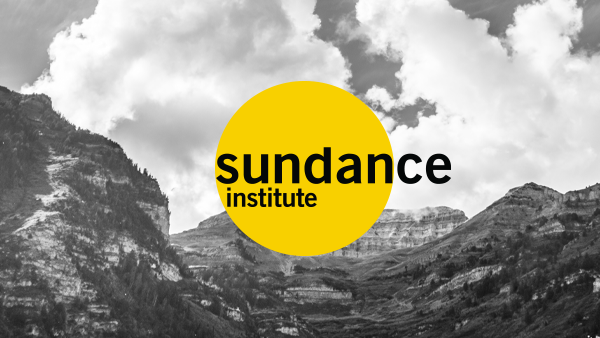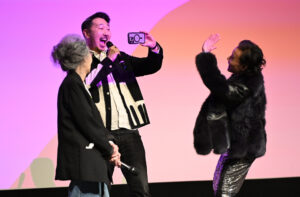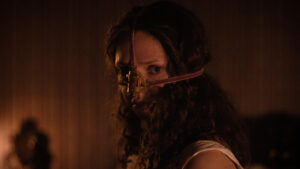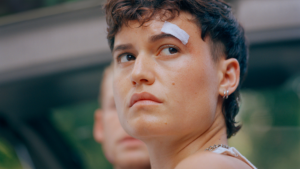Meredith Lavitt, Associate Director, Film Forward
Film Forward is all about creating cultural exchange through the exhibition of films and conversations with filmmakers. It’s about making connections with artists, youth, and everyday people, and finding similarities and dispelling differences. It is a worthy mission with an impact that can resonate, but we had to put it in the context of what was happening in the Horn of Africa. On our first day in Nairobi, Kenya, we met with Embassy officials to discuss Film Forward. As we were meeting, cell phones were ringing, cryptic conversations were taking place, and one of our liaisons at the Embassy who is in charge of the Somali mission informed us that there was going to be an official announcement – The Horn of Africa was experiencing the worst famine in 60 years. It is the worst humanitarian crisis in the world today with more than 12 million people suffering. We were originally supposed to take the Film Forward program to Dadaab, a refugee camp that is predominantly made up of Somalis and is being hit hardest by the repercussions of the famine. The camp was designed for 80,000 people, but it now holds well over 380,000 and each day a staggering 1,500 people are reported to be arriving.
Prior to the trip and the announcement, we had decided–due to the large influx of refugees each day, a growing security concern, and a basic lack of accommodation for guests–to forego Dadaab and let the Film Forward films travel to Dadaab with the FilmAid Film Festival. Our program would instead visit the Kakuma Refugee camp in the northwest of Kenya near Sudan. Kakuma is made up of 40% Somalis, a large majority of Sudanese, and then a mix of other cultures from Somalia, Ethiopia, Burundi, the Democratic Republic of Congo, Eritrea, Uganda, and Rwanda. Upon learning about the incredible humanitarian crisis, screening films for refugees seemed frivolous. The experiences we had would prove otherwise…
Nairobi and Mathare
We started our program in Nairobi, a major metropolitan hub. Twenty years ago I had lived there as part of a student exchange program. Back then, to cross the street you needed to wait for a group of people to collect in order to make a mass crossing because cars drove fast and did not stop. Today it is so thick with cars, buses, mutatus (a van that has become a Kenyan privatized transport system) and trucks, that more often than not traffic moves at a crawl. To get from one area to the next can take an hour, and diesel exhaust fumes burn your eyes and throat and cloud the air. Traffic is not the only problem endemic to a grown-up Nairobi; population and housing are also significant challenges. Nairobi is home to one of the largest slums in urban Africa. FilmAid International works in the slums of Nairobi, Kibera, and Mathare, training youth in filmmaking and providing entertainment and community experiences with outdoor screenings. On our first night, Sundance Institute Executive Director Keri Putnam, her daughter Lucy, and I took an hour and a half long drive to Mathare to watch an outdoor screening of Soul Boy, a film made by a local Kenyan with the support of Tom Tykwer’s organization One Fine Day Films, an alternative production company dedicated to empowering Kenyan filmmakers from the slums. Soul Boy was programmed as part of the FilmAid Festival.
There was an immediate transformation once we entered the slums. The streets were dense with people milling about and selling their wares. Shacks were crammed next to each other, utilizing every available space of real estate. We drove down a street in our white van, with our “muzungu,” faces, which is the Swahili word for “white person” and literally means “confused person wandering about.” That was exactly what we were as our van snaked its way through the crowded street and our faces shined like torches. We were informed that for the most part, not even Kenyans enter the slums–it is a community that leaves to go to work, but people from the outside are not as welcome in. That feeling of not being welcome quickly dissipated when we arrived at the screening. I was overcome with amazement; hundreds of people had gathered to watch the film. We felt quite safe.
The screening area was a natural amphitheater, an old rock quarry. People sat and stood at the bottom of the quarry and a wall of people watched from the dug out cliffs above, looking almost level with the screen. We met Liz Manne, executive director of FilmAid International and a board member of the President’s Committee on the Arts and the Humanities (PCAH), along with Alfre Woodard, who was there with a delegation from the Academy of Motion Pictures, Arts and Sciences and also a board member with Liz on PCAH. Film Forward was in Kenya partnering with FilmAid International, while AMPAS was there to work with One Fine Day Films and their Film Africa program (providing film training workshops and mentorship to Africans). Later in the week the three organizations, along with the Sundance Institute Theatre Program, would collaborate on a panel discussion on storytelling across mediums.
We were a small group of about eight people, but unfortunately, no sooner than we arrived, we were told we had become a major distraction. Although security was quietly in place, some of the driver’s felt uncomfortable in the slums and demanded we leave. After a brief 10 minutes, we climbed back in the vans to drive yet again for an hour an half back to our hotel. It was heartening, however, to be part of the screening, if only for a moment. Kenyans from one of the poorest neighborhoods had gathered as a community to watch a film made by a Kenyan. Later that week both Boy and A Small Act would play in Mathare and Kibera, and I was sad to miss the opportunity to be a part of those events.
In the next couple of days we conducted smaller screenings, workshops and a panel discussion in Nairobi at several venues. One of the venues, the GoDown Center, is in the industrial center of town, not convenient to get to, but well worth the trip. The centre provides the first Kenyan multi-disciplinary space for arts and host organizations representing a variety of art-form and residence programs. Its mission is to develop independent artists across multiple art forms and to participate in the advancement of the cultural sector–a perfect match for Film Forward. The GoDown is vibrant and the artistic vibe is inside and out. Amazing urban graffiti art decorates the building walls and it was a great photo opportunity for Taika, who posed with audience members in front of one of the buildings with a larger than life depiction of Michael Jackson–it was very Boy (see the film to get the Michael Jackson reference). Both filmmakers held workshops at the GoDown and it was also the home of our “Storytelling Across Mediums” panel with the Theatre program and AMPAS. The panel came together very quickly and we were fortunate to have Orlando Bagwell from the Ford Foundation moderate the discussion. It was a lively conversation about what mediums artists choose to tell their stories and their ability to impact social change and advance the public’s agency to act on affairs affecting their lives.
Kakuma

FilmAid student Sammy. Photo by Meredith Lavitt.
Next we traveled to Kakuma. The camp is much more stable than Dadaab, and without proper orientation it feels like any other Kenyan village, just tremendously larger with a population of 80,000. We were hosted in the camp by our partner for Film Forward Kenya–FilmAid International. FilmAid regularly presents outdoor and indoor screenings to the refugee community, and in particular to a group of young aspiring filmmakers who are enrolled in the Participatory Video Program (PVP), where they learn how to make films and are empowered to tell their stories. The Kakuma camp is laid out in three zones, and each zone is broken down into areas designated for certain ethnicities. We discovered a disturbing dynamic about the camp and the host community, the Turkana People. There is a huge discrepancy between the wealth of some of the refugees in the camp (some are assisted by relatives living abroad) and the Turkana People who have given their land for the use of the camp. The Turkana are among some of the poorest people in Kenya and many of them come into the camp and work for the refugees. We were told it is the only refugee camp where this economic model exists; in all other camps the refugees are the ones seeking the employment of the host community. The Turkanas became a daily topic of discussion and FilmAid is working on programs that will give them similar opportunities to tell their stories through film.
On our second night in the camp we had two outdoor screenings. It was truly a brilliant experience to watch 2,000 people, mostly children, jockey for position to see an outdoor screening of A Small Act. The audience was a mix of ages, but the eyes of the youth were electric. It probably could have been any movie for them, but the fact that is was a movie about Kenyans and focused on an issue that was familiar–the challenge of education–seemed to draw the audience into the cinematic experience. The activity alone also created a huge sense of community for a group of people who are displaced and living largely day-to-day. During the screening, one of the FilmAid students, Samson “Sammy,” a bold 17-year-old who has made a few films, was standing next to me at the start of A Small Act. He looked like he was about to leave, so I asked him why. “Meredith,” he said in his Ethiopian accent, “documentaries are not for me.” I replied back, “Sammy, I promise you this will be like no other documentary you have seen, you will not be able to walk away, please stay for me and tell me what you think at the end.” As the movie reeled forward I kept my eye on Sammy, he was completely engrossed, standing with his hand on his head, over his mouth, and gesturing to the screen. Right about the time where the kids in the film are about to take their exams, there is a scene where the wooden benches are being moved into the testing room. I heard Sammy exclaim, “Oh no, you really don’t want to sit on those for these tests, way too uncomfortable.” Fifteen minutes later the three subjects in the film were awaiting the results of their exams. Would they get a score to provide them a scholarship from the Hilde Back Education Fund and allow them to go to secondary school? I walked over to Sammy and asked, “So Sammy, what do you think of this documentary?” He looked at me and replied, “Meredith, you don’t understand, this is very personal, very personal, you know these exams are so…,” he shook his head and continued watching. It was a moment I will remember for a long time–a beautiful example of the power of storytelling and film to transform, transcend, and connect. Sammy no longer cared that he was watching a documentary, he was relating and engaged.
Rain, Snake, Scorpion
At the start of the screening, just as all had gotten settled, the peeps of the younger children had quieted, the dialogue of the film had filled the air, and we had taken a deep breath that the projection was working–complete and utter pandemonium ensued. More than 1,000 children jumped and shrieked and ran in every direction. I was standing next to Sammy, and Jennifer Arnold and Jane Muigai were near. Sammy and I ran towards the commotion, Jen braced herself against the pillar holding up the outdoor structure we had gathered under, and Jane sat there completely calm. Jen was ready for a stampede. Jane, who grew up in the village of A Small Act and is one of the main characters in the film, knew from experience there was no need to worry. But Sammy and I wanted to know what was happening. I saw so many children, all I could think about was one of them is going to get trampled. My first thought was that maybe one of those famous African down pours had started even though we were dry, and Sammy thought maybe a snake. Then we heard people yelling “scorpion,” and the children panicked. Fortunately, it was a false alarm and relatively quickly everyone settled back down and the film resumed.
Screenings and Workshops

Two refugee youth showing off their moves. Photo by Meredith Lavitt.
Having lived in Kenya and held other Film Forward programs in developing countries, I was keenly aware and also well warned by FilmAid that things would not go as planned. There would be technical challenges and events would not start on time, but we did our best to keep things in perspective. At times it felt like we were not being as effective as we could be, but then I would read an evaluation, or speak with an audience member and be reminded about the opportunity we were providing–we were showing films from around the world and having discussions with filmmakers and it was valuable. Both filmmakers led interesting workshops on storytelling, and probably the best experience for all, was a workshop attended by the participatory video program PVP students who showed us their work and discussed story ideas with Jennifer and Taika. The exchange provided a great opportunity for the refugee youth and aspiring filmmakers to learn from the Film Forward filmmakers, and for us to learn from them–what stories are important to them, how they tell stories, and how best for us to communicate universal story ideas and help shape their ideas so they resonate beyond their community. The PVP students live in a refugee camp, many call it home and may never leave, but all want to connect globally.
We had some funny moments too. In the camp it takes about 30 minutes to get between locations. Taika and I left for a Q&A on his film Boy and were informed along the way that most of the audience left to get their food bags, but that FilmAid had convinced about five people to stay. We adjusted our expectations and embraced an intimate conversation. We arrived to a packed house of about 20 five-year-olds and a few adults, most of whom had not seen the film. It was a bit of a stretch to get the audience to engage in a Q&A, and finally out of desperation I polled the audience to see if they knew who Michael Jackson was. One kid got up and put on some music and began to dance–the floodgates were open. Overall, the issue of audience engagement was a definite challenge, as most of these cultures are not used to this type of dialogue and women are especially shy and not encouraged to speak. We found that the smaller groups, and the ones primarily attended by the PVP students were always the most engaging.
After many conversations with PVP students, I was amazed how connected they are, despite living in a refugee camp without electricity, running water, and other basic needs. I now have many new Facebook friends, and although connecting to the internet was nearly impossible for all of us Muzungus, the PVP students have it dialed and I hope to see their posts from Kakuma soon!







